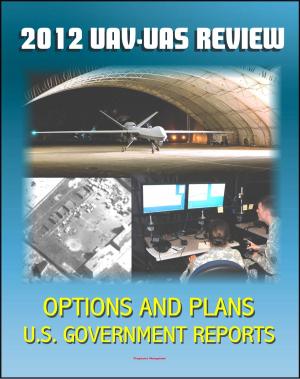The Struggle for Air Force Independence 1943-1947: Roots of AAF, Marshall and Forrestal, Eisenhower, Truman, Plans for Unification, JCS, Postwar, Moving Toward Autonomy, Establishing the USAF
Nonfiction, History, Military, Aviation| Author: | Progressive Management | ISBN: | 9781311226747 |
| Publisher: | Progressive Management | Publication: | August 11, 2015 |
| Imprint: | Smashwords Edition | Language: | English |
| Author: | Progressive Management |
| ISBN: | 9781311226747 |
| Publisher: | Progressive Management |
| Publication: | August 11, 2015 |
| Imprint: | Smashwords Edition |
| Language: | English |
Professionally converted for accurate flowing-text e-book format reproduction, this Air Force publication is the definitive accounting of the creation and establishment of the United States Air Force. As such, it is fitting that it is now released in a new and expanded edition, in honor of the fiftieth anniversary of the creation of the USAF as a separate military service. It is a masterful work of unquestioned stature.
As author Herman Wolk demonstrates, the creation of the USAF was hardly the product of casual intent. The creation represented the fulfillment of both a desire and a need dating back to the experiences of the Army Air Service in the First World War, the doctrinal controversies of the interwar years, and the crucible of global combat in the Second World War. It was this legacy of struggle and effort that shaped the service and its leadership. If for no other reason than this, the creation of the United States Air Force can thus be seen as far more than merely the result of the emergence of atomic weaponry and a bipolar post-Second World War global environment, or that of enthusiastic impulse borne of America's wartime air power experience.
But if the Air Force necessarily represented the product of a long tradition of air power thought and activity, it had nevertheless purchased its birthright with the blood and sacrifice of innumerable air and ground crews in combat around the world. In 1943, General George C. Marshall, the Chief of Staff of the U.S. Army, had seen fit to issue the then-Army Air Forces with its Declaration of Independence: FM 100-20, which recognized the co-equality of air and land power. Two years later, his successor, General of the Army Dwight D. Eisenhower, was one of the strongest proponents of Air Force independence. He was in a position to know: in June 1944, after D-Day, he had remarked to his son John (a newly minted Army second lieutenant visiting his father in Normandy), "Without air supremacy, I wouldn't be here." It was the Army Air Forces that had secured that air supremacy. Given the significance of air power in the modern world, he well recognized that the best means of projecting that air power and meeting the increasing global requirements thrust upon the United States was via a strong, well-led, well-equipped, and well-trained independent Air Force.
Chapter 1 - Roots of AAF Organization * Early Air Organization * General Headquarters Air Force * Air Organization in World War II * Anticipating Postwar Reorganization. * Chapter 2 - Planning for 70 Groups * Early Postwar Planning * Marshall Orders a Resurvey * AAF Protests Resurvey * The War Department and UMT * Establishing the 70-Group Goal * Jamison's Dissent to Bessell Committee * Arnold Urges 70 Groups * Final Approval for 70 Groups * 70 Groups vs UMT * Chapter 3 - Unification and a Separate Air Force * Joint Chiefs of Staff Special Committee Report * The Navy's View of the Report * Views of Arnold and Marshall * Forrestal on Autonomy * Eisenhower Supports a Separate Air Force * Truman Advocates a Coequal Air Force * The AAF Plans for Unification * Chapter 4 - Organizing The Postwar Air Force * Continental Air Forces * Strategic Striking Force * Postwar Organization of Major Commands * Planning the Headquarters Organization * Establishment of the Air Board * War Department Circular 138 * Chapter 5 - Moving Toward Autonomy * Truman Increases the Pressure * Norstad and Sherman Draft a Plan * Agreement between Patterson and Forrestal * Struggle over Roles and Missions * Executive Order 9877 * National Security Act of 1947 * Chapter 6 - Independence and Organization * "At Long Last" * Establishing the Air Force * Organizing the Headquarters * Planning the Technical Services * Transfer of Functions * Chapter 7 - Epilogue
Professionally converted for accurate flowing-text e-book format reproduction, this Air Force publication is the definitive accounting of the creation and establishment of the United States Air Force. As such, it is fitting that it is now released in a new and expanded edition, in honor of the fiftieth anniversary of the creation of the USAF as a separate military service. It is a masterful work of unquestioned stature.
As author Herman Wolk demonstrates, the creation of the USAF was hardly the product of casual intent. The creation represented the fulfillment of both a desire and a need dating back to the experiences of the Army Air Service in the First World War, the doctrinal controversies of the interwar years, and the crucible of global combat in the Second World War. It was this legacy of struggle and effort that shaped the service and its leadership. If for no other reason than this, the creation of the United States Air Force can thus be seen as far more than merely the result of the emergence of atomic weaponry and a bipolar post-Second World War global environment, or that of enthusiastic impulse borne of America's wartime air power experience.
But if the Air Force necessarily represented the product of a long tradition of air power thought and activity, it had nevertheless purchased its birthright with the blood and sacrifice of innumerable air and ground crews in combat around the world. In 1943, General George C. Marshall, the Chief of Staff of the U.S. Army, had seen fit to issue the then-Army Air Forces with its Declaration of Independence: FM 100-20, which recognized the co-equality of air and land power. Two years later, his successor, General of the Army Dwight D. Eisenhower, was one of the strongest proponents of Air Force independence. He was in a position to know: in June 1944, after D-Day, he had remarked to his son John (a newly minted Army second lieutenant visiting his father in Normandy), "Without air supremacy, I wouldn't be here." It was the Army Air Forces that had secured that air supremacy. Given the significance of air power in the modern world, he well recognized that the best means of projecting that air power and meeting the increasing global requirements thrust upon the United States was via a strong, well-led, well-equipped, and well-trained independent Air Force.
Chapter 1 - Roots of AAF Organization * Early Air Organization * General Headquarters Air Force * Air Organization in World War II * Anticipating Postwar Reorganization. * Chapter 2 - Planning for 70 Groups * Early Postwar Planning * Marshall Orders a Resurvey * AAF Protests Resurvey * The War Department and UMT * Establishing the 70-Group Goal * Jamison's Dissent to Bessell Committee * Arnold Urges 70 Groups * Final Approval for 70 Groups * 70 Groups vs UMT * Chapter 3 - Unification and a Separate Air Force * Joint Chiefs of Staff Special Committee Report * The Navy's View of the Report * Views of Arnold and Marshall * Forrestal on Autonomy * Eisenhower Supports a Separate Air Force * Truman Advocates a Coequal Air Force * The AAF Plans for Unification * Chapter 4 - Organizing The Postwar Air Force * Continental Air Forces * Strategic Striking Force * Postwar Organization of Major Commands * Planning the Headquarters Organization * Establishment of the Air Board * War Department Circular 138 * Chapter 5 - Moving Toward Autonomy * Truman Increases the Pressure * Norstad and Sherman Draft a Plan * Agreement between Patterson and Forrestal * Struggle over Roles and Missions * Executive Order 9877 * National Security Act of 1947 * Chapter 6 - Independence and Organization * "At Long Last" * Establishing the Air Force * Organizing the Headquarters * Planning the Technical Services * Transfer of Functions * Chapter 7 - Epilogue















